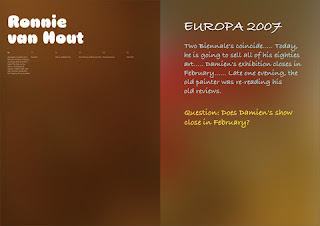In the Business section of the New York Times, 'The Art of Buying Art, With the Help of an Adviser' looks at advisors from the services point of view. Good things about advisors include:
- they can educate you about art, and introduce you to new artists and galleries
- they can get you access to stockrooms and waiting lists
- they can do the legwork you're too busy for
- they can help you decide what to bid at auction
- they can 'mediate between a husband and wife on a big purchase' (quote from New York-based artist Marilyn Greenberg).
Meanwhile, in The Art Newspaper, 'The problem with art advisors' has a much less rosy view. Bad things about advisors include:
- they have 'Gucci clothes and that perfect hair, but there’s no passion for art' (quote from Berlin gallerist Guido Baudach)
- art fairs have made it much easier for them to approach art dealers, as dealers are 'on the floor and totally accessible' (quote from Glenn Scott Wright, director at Victoria Miro Gallery, London)
- there's a new and less respectable breed of advisor who 'go around crashing cocktail parties and shimmying up to people who just got a big bonus at Goldman Sachs' (quote from David Leiber of Sperone Westwater gallery in New York)
Okay - so far, so funny. But The Art Newspaper article does raise a more substantial issue.
There's a number of different ways that art advisors make their money. Not everyone is happy with all of them, and there have been cases where an art advisor has double-dipped without the client's knowledge. This is where the article gets interesting. Ways of making a cut include:
- being paid a retainer, usually related to the size of the collection being built, and the speed with which it is to be developed
- being paid a commission on each work from the gallery it's purchased from
- being paid a commission by both the gallery and the client.
So how about here in New Zealand? The gallery system here is still pretty egalitarian. There's only a handful of artists whose work you might not be able to purchase just by turning up at the opening with your chequebook.
Getting the really good stuff though, especially by older or historical artists, probably requires building a relationship with the right dealer/s. By and large, this isn't hard: the dealers here are a relatively friendly bunch.
In my opinion, the times you might want an advisor would be when (a) you have lots of money, little knowledge of New Zealand art, and less time (b) you're looking to buy on the secondary market, and you need someone to help you sniff out the work, and evaluate it or (c) when you want to branch out of the area you're familiar with and start collecting in a different period or media.
So - where to find one? Don't use the Yellow Pages. Ask around and get a recommendation from another collector (whose collection you admire), a gallery curator (whose shows and publications you admire), or an art dealer (who runs a business that you admire).






